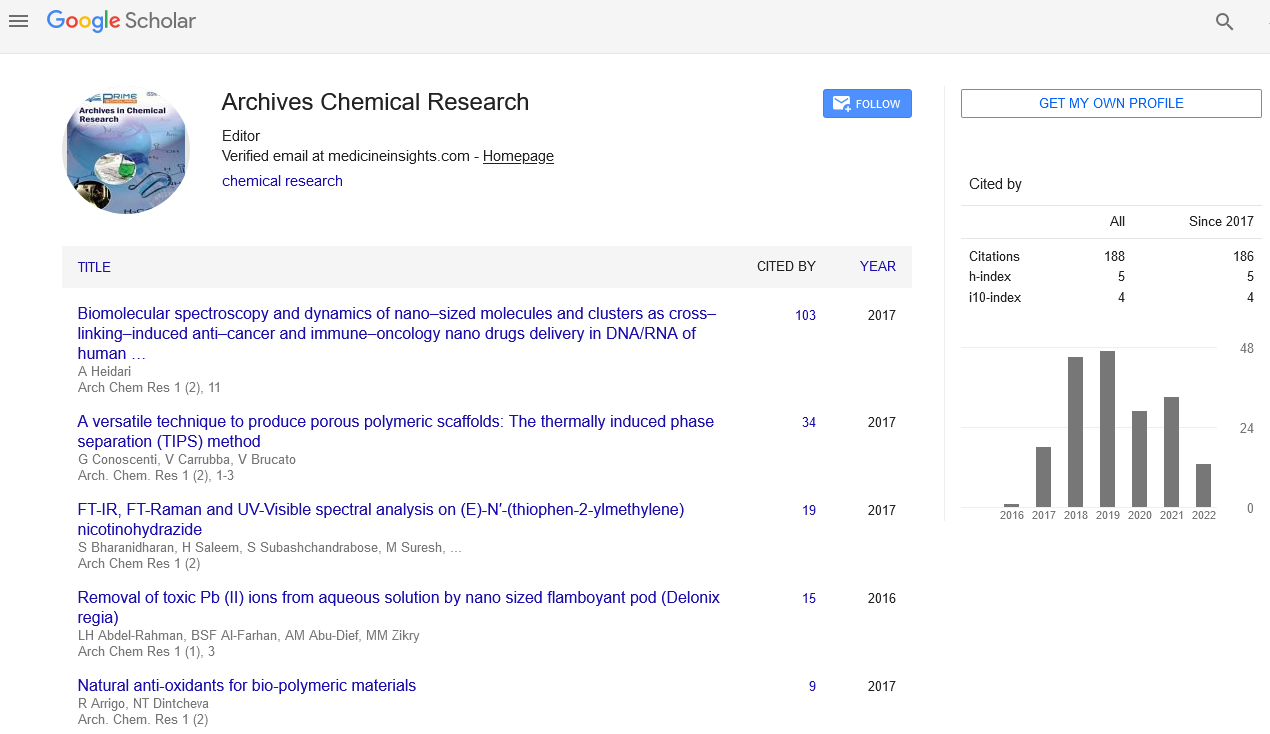Short Communication - (2024) Volume 8, Issue 2
Understanding Mass Spectrometry: A Powerful Analytical Tool
Jacob King*
Department of Organic Chemistry, Cumbria University, United Kingdom
*Correspondence:
Jacob King,
Department of Organic Chemistry, Cumbria University,
United Kingdom,
Email:
Received: 29-May-2024, Manuscript No. PACRH-24-20304;
Editor assigned: 31-May-2024, Pre QC No. PACRH-24-20304 (PQ);
Reviewed: 14-Jun-2024, QC No. PACRH-24-20304;
Revised: 19-Jun-2024, Manuscript No. PACRH-24-20304 (R);
Published:
26-Jun-2024, DOI: 10.35841/2572-4657.8.02.11
Introduction
Mass Spectrometry (MS) is a sophisticated analytical
technique used to measure the mass-to-charge ratio of ions.
It is a crucial tool in various fields, including chemistry, biology,
environmental science, and medicine. The core principle of
mass spectrometry involves ionizing chemical compounds
to generate charged molecules or molecule fragments and
measuring their mass-to-charge ratios. This allows scientists
to identify and quantify substances within a sample, offering
insights into their composition and structure. The first step
involves converting the molecules of a sample into ions. There
are several ionization techniques, each suitable for different
types of samples. Common methods include Electron Ionization
(EI), Matrix-assisted Laser Desorption/Ionization (MALDI),
and Electrospray Ionization (ESI). EI is widely used in gas
chromatography, where a sample is vaporized and bombarded
with electrons, causing the molecules to lose electrons and
form positive ions. ESI, on the other hand, is particularly useful
for large biomolecules like proteins, where the sample is
ionized by applying a high voltage to a liquid sample [1,2].
Description
Once the ions are generated, they are separated based on
their mass-to-charge ratios using a mass analyser. There are
various types of mass analysers, such as Quadrupole, Timeof-
Flight (TOF), and Ion Trap. The Quadrupole mass analyser
uses oscillating electrical fields to filter ions of different massto-
charge ratios. TOF analysers measure the time it takes for
ions to travel a known distance, with lighter ions reaching
the detector faster than heavier ones. Ion Traps capture ions
in a dynamic electric field, allowing for detailed analysis and
manipulation. The final step involves detecting the ions and
generating a mass spectrum. A mass spectrum is a plot of
the ion signal as a function of the mass-to-charge ratio. The
detectors, often electron multipliers or Faraday cups, measure
the abundance of each ion, providing data that can be used
to identify and quantify the components of the sample. Mass
spectrometry has a wide range of applications due to its
versatility and sensitivity. In proteomics, mass spectrometry is
essential for identifying and characterizing proteins in complex
biological samples. Techniques like tandem mass spectrometry
(MS/MS) are used to sequence peptides and determine
post-translational modifications, crucial for understanding
cellular processes and disease mechanisms. MS is used
to detect and quantify pollutants in the environment. For
instance, it can identify trace levels of pesticides, herbicides,
and heavy metals in water, soil, and air samples, helping in
monitoring and managing environmental health. In medicine,
mass spectrometry aids in diagnosing diseases by analysing
biomarkers in biological fluids. It is used in new-born screening
to detect metabolic disorders and in pharmacokinetics to
study drug metabolism and dynamics. Ensuring the safety and
authenticity of food products is another critical application. MS
can detect contaminants, such as toxins and pathogens, and
verify the composition and origin of food products, preventing
food fraud and ensuring consumer safety. The field of mass
spectrometry is continually evolving, driven by technological
advancements and new applications. Innovations in ionization
techniques, mass analysers, and data processing are enhancing
the sensitivity, accuracy, and speed of mass spectrometric
analysis [3,4].
Conclusion
Recent developments include the integration of MS with other
analytical techniques, such as chromatography, to create
powerful hybrid methods like GC-MS (Gas Chromatography-
Mass Spectrometry) and LC-MS (Liquid Chromatography-
Mass Spectrometry). These combinations allow for more
comprehensive analysis of complex samples. Looking forward,
the miniaturization of mass spectrometers is a promising area,
with portable devices enabling on-site analysis in various
settings, from field studies to clinical diagnostics. Moreover,
advancements in bioinformatics and machine learning are
improving the interpretation of complex mass spectrometry data, facilitating the discovery of new biomarkers and
therapeutic targets. In conclusion, mass spectrometry is an
indispensable tool in modern science and industry, providing
detailed molecular insights that drive innovation and safeguard
health and the environment. As technology progresses, its
applications and impact will continue to expand, offering new
opportunities for discovery and development across diverse
fields.
Acknowledgement
None.
Conflict Of Interest
The author’s declared that they have no conflict of interest.
References
- Coley CW, Thomas DA, Lummiss JAM, Jaworski JN, Breen CP, et al. (2019) A robotic platform for flow synthesis of organic compounds informed by AI planning. Science. 365(6453): eaax1566.
[Crossref] [Google Scholar]
- Greenaway RL, Jelfs KE, Spivey AC, Yaliraki SN (2023) From alchemist to AI chemist. Nat Rev Chem. 8:527-528.
[Crossref] [Google Scholar]
- Roch LM, Hase F, Kreisbeck C, Tamayo-Mendoza T, Yunker LPE, et al. (2018) Aspuru-Guzik ChemOS: Orchestrating autonomous experimentation. Sci Robot. 3(19):5559.
[Crossref] [Google Scholar]
- Zhu H (2020) Big data and artificial intelligence modeling for drug discovery. Annu Rev Pharmacol Toxicol. 60:573-589.
[Crossref] [Google Scholar]
Citation: King J (2024) Understanding Mass Spectrometry: A Powerful Analytical Tool. Arch Chem Res. 8:11.
Copyright: © 2024 King J. This is an open-access article distributed under the terms of the Creative Commons Attribution License, which permits unrestricted use, distribution, and reproduction in any medium, provided the original author and source are credited.

